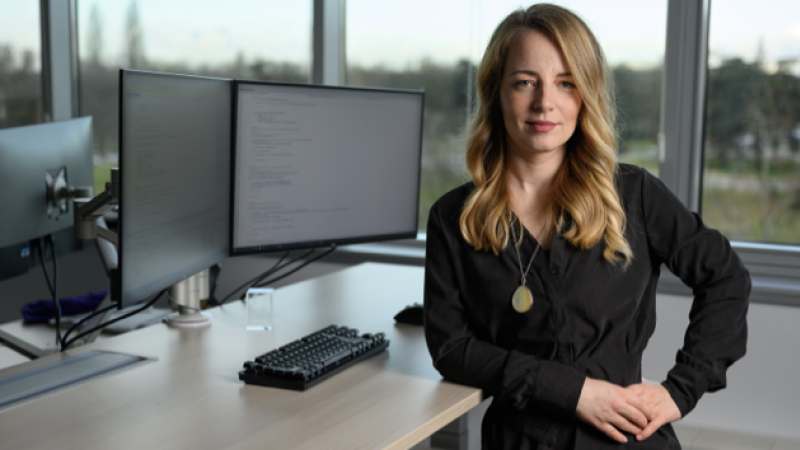The world of information technology is the fastest growing area today, offering development opportunities, both for all its areas and all the people who embark on it. February 11th is the International Day of Women in Science, so on that occasion we talked to Ana Manić, software engineer at the Microsoft Development Center in Serbia, about how she entered the world of information technology, how she feels in it today, but also where she sees her future within this industry.
Was your first encounter with programming love at first sight or did it take a little more time for you to discover all its charms?
I met programming for the first time at the Mathematical Grammar School in Belgrade, where, in addition to traditional natural sciences, a lot of focus is placed on the development of programming skills. I did not see programming as something that is not for girls, because everything we learned in school was equally accessible to everyone and everyone could choose how to widen their knowledge based on their preferences. However, at that time, girls were a minority in my high school, and this trend continued later in college, PhD studies and work, with the percentage of girls and women in my environment declining at every step.
Although I became acquainted with programming in high school, my love for it only developed during my PhD studies. Until then, I had studied programming because I needed to solve technical and engineering problems I encountered; however, while preparing my PhD thesis, my love for programming distributed systems awoke. In high school, what I liked the most were the algorithms or mathematical ideas used in programming. However, over time, I have realized that math is an integral part of programming. When solving a more complex programming problem you have to include logical thinking, experience gained, a bit of math, a lot of imagination and of course – advanced coding knowledge.
I think that young people today have the opportunity to discover the hidden world that unlocks programming knowledge much earlier, and that they can more easily find the part of this world that interests them the most.
Did you immediately know what you wanted to do within this industry, which is quite diverse, or did it take time for you to find yourself? And now that you’ve found you love to do, what’s your favorite part of the job?
My education is, in fact, quite non-standard for people involved in software development because I have found that calling quite late in life. I completed my undergraduate studies at the Faculty of Electrical Engineering in Belgrade, majoring in electronics, and after that my PhD studies in numerical electromagnetics in Colorado, USA. Namely, during my PhD studies, I was writing the software that performed numerical analysis on a distributed computer system, and over time I had realized that software implementation, and everything related to it, was actually the most interesting part of what I was doing. Then I turned to cloud computing, which is basically a distributed computer system, and looked for a job at MDCS. Since then, I have been part of the Azure Data team that has been developing products for Microsoft Cloud. Although the job I do is very interesting, what I like the most about it is working with people. The environment in MDCS is such that it constantly pushes you forward, learning from the people around you on a daily basis. I think this is an indispensable part of my job and I want to tell young people to try to find such an environment for themselves, in which they can constantly grow and develop.
Which formula is winning when it comes to a successful team?
I believe that any team, in any sphere of work, becomes boring and unimaginative if all its members are similar to each other. Also, such an environment always repeats the same mistakes and can hardly reach its optimal potential. That is why it is important that everywhere, even in the teams of programmers, there are different personalities, with diverse knowledge and life experiences, different educational backgrounds and different opinions. I don’t think there are specific advantages that only men or only women can bring to the team, each person is different and has something special and in order to achieve balance in the team, you need to have both women and men in it. I have the impression that software companies recognize this fact.
Unfortunately, schoolgirls, especially in their teens, do not have the support of the environment to enter the world of programming. That is why it is important for our entire society to understand that the IT industry is the future which is open to everyone. It is quite heterogeneous, it stimulates imagination and intelligence, and while in some of its spheres one needs to know languages and have philological background, in others it is crucial to have desire to play “with gadgets”. Anyone who loves mathematics and physics can find an IT field where they can apply their knowledge. Those who find the traditional way of learning boring often find their place in IT industry – you learn through work and through the creation of something new. When you encounter a problem, or find a “bug”, you try to fix it, not even thinking about the fact that you learn more in this process than while preparing for exams.
Microsoft firmly believes that greater participation of women in IT guarantees both more comprehensive and diverse information and communication technology solutions and gives full support to the “Schools for the 21st Century” project, organized by the British Council, although it does not participate directly in the project.





